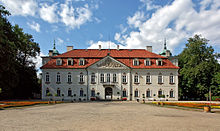Nieborów
| Nieborów | ||
|---|---|---|

|
|
|
| Basic data | ||
| State : | Poland | |
| Voivodeship : | Łódź | |
| Powiat : | Łowicki | |
| Gmina : | Nieborów | |
| Geographic location : | 52 ° 8 ′ N , 20 ° 7 ′ E | |
| Residents : | 900 (2006) | |
| Postal code : | 99-416 | |
| Telephone code : | (+48) 46 | |
| License plate : | ELC | |
| Economy and Transport | ||
| Rail route : | Warsaw – Łowicz | |
| Skierniewice – Łowicz | ||
Nieborów is a village and seat of the rural municipality of the same name in Poland in the Łódź Voivodeship . It is the seat of the rural community of the same name with 9382 inhabitants (as of June 30, 2019). The village is known for the castle of the same name and the important baroque garden . Nearby is the associated Arkadia Park .
history
The beginnings of Nieborów go back to the end of the 12th century. In 1324 a church was built. In addition, there was a wooden mansion in the place even then. The place name Nieborów is mentioned for the first time in church records from the 14th century in connection with the collection of St. Peter's penny .
At the beginning of the 16th century, a manor was built in Nieborów in a transition style between Gothic and Renaissance . This courtyard was used until the end of the 17th century. The Nieborów estate was then owned by the Nieborowski family. They sold the estate in 1694 to the Primate of Poland, Cardinal Michael Stephan Radziejowski , who had a baroque palace and garden built here by the architect Tylman van Gameren , builder of the Royal Chapel in Danzig .
After the cardinal's death, the property changed hands frequently, before it passed in 1774 to the art-loving Michał Hieronim Prince Radziwiłł, who later became voivode of Vilnius. Prince Radziwiłł had the palace decorated with furniture and works of art in the style of the time. He founded an extensive library with over 10,000 volumes, including incalibular prints from the 15th century and the oldest printed product in Poland. Prince Radziwiłł also set up an extensive picture gallery: he collected Dutch, German, Italian and Spanish paintings as well as portraits of Polish and foreign dignitaries. The copper engraving cabinet attached to the picture gallery contained between ten and twenty thousand sheets.
Prince Radziwiłł had Simon Gottlieb Zug create a regular French garden in front of the palace in the early 1770s.
The prince was also interested in the economic interests of his property and was open to the introduction of new agricultural methods. His wife, Helena, b. Przeździecki, was also a great collector and art patron. She initiated the romantic garden a few kilometers away and named it Arkadia . Enlightenment artists met here . The pavilions were decorated with numerous works of art. The princess collected Greek and Roman antiquities.
After Michał Hieronim Radziwiłł's death in 1831, no one paid any attention to Nieborów, as there was a dispute over the inheritance that had lasted for years. The estate was left to its own devices for ten years, then, in 1841, Michał Hieronim's son, Michał Gedeon Prince Radziwiłł, took over Nieborów. Michał Gedeon Radziwiłł was a general and one of the chief commanders of the Polish November uprising of 1831. After his death, the estate passed into the possession of his son Zygmund Prince Radziwiłł. However, this turned out to be a serious wasteful and gradually ruined Nieborów economically. To get money, he had the best part of the picture gallery and library auctioned off in Paris. He also sold Arkadia with his valuable works of art to strange hands. Fortunately, Zygmund Radziwiłł ceded the estate to his nephew Michał Piotr Radziwiłł in 1879 and emigrated to France. The new owner bought Arkadia back and founded a majolica factory in 1881 , which also equipped the castle with decorative tiled stoves and art ceramics. A furniture manufacturer was also founded at that time. Michał Piotr Radziwiłł also endeavored to supplement the library's holdings through new purchases. He died childless in 1903. His widow sold Nieborów three years later to a distant cousin, Janusz Radziwiłł. He was a politician in the interwar period and had the interior of the palace partially rebuilt between 1922 and 1929. He made Nieborów a fashionable meeting place, which was visited by politicians and representatives of high society. Janusz Radziwiłł remained in the possession of Nieborów until February 1945. Then the family was abducted by the NKVD and taken to a camp near Krasnogorsk , where Janusz Radziwiłł's wife died. He himself was able to return to Warsaw in 1947, but the palace and the garden ensemble of Nieborów and Arkadia had already been nationalized and opened to the public as a branch of the National Museum of Warsaw. Janusz Radziwiłł died in 1967.
In Nieborów the filming of the children's film "Akademia Pana Kleksa" ("The Academy of Mr. Klecks"), known in Poland, took place.
local community
The rural community (gmina wiejska) Nieborów includes the village itself and other villages and towns with a total of 19 school offices.
traffic
The Bednary station and the Mysłaków stop on the Warszawa – Poznań railway line are in the municipality ; Bełchów station and Bobrowniki station on the Skierniewice – Łowicz railway line .
lock
See main article: Nieborów Palace
Sons and daughters of the village
- Józef Jarzębski (1878–1955), violinist and music teacher
- Wilhelm Kotarbiński (1848–1921), Polish-Russian painter.
literature
- Krzysztof Jabloński, Włodzimierz Piwkowski: Nieborów, Arkadia. Warszawa 1996. ISBN 83-7079-598-6

